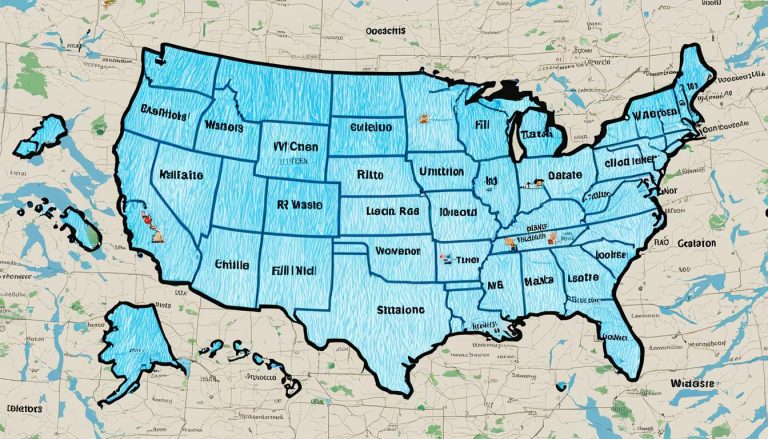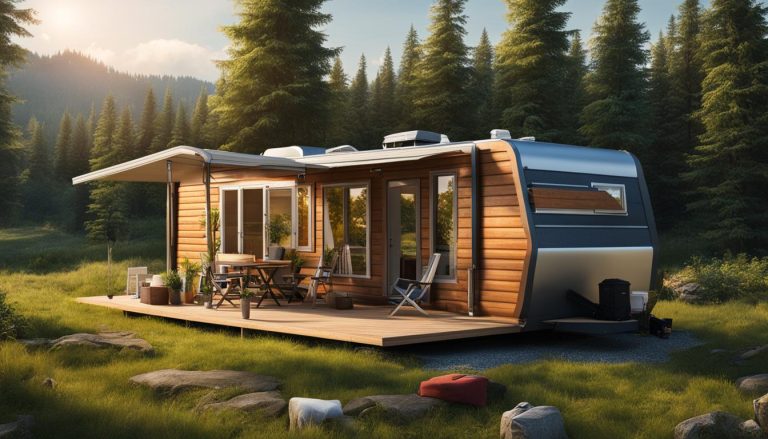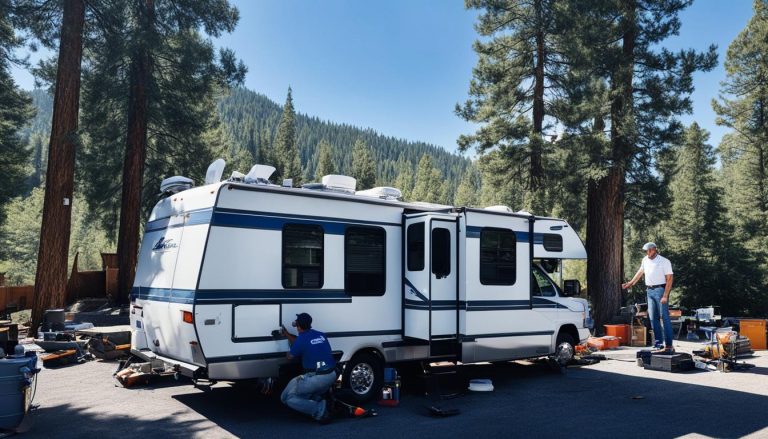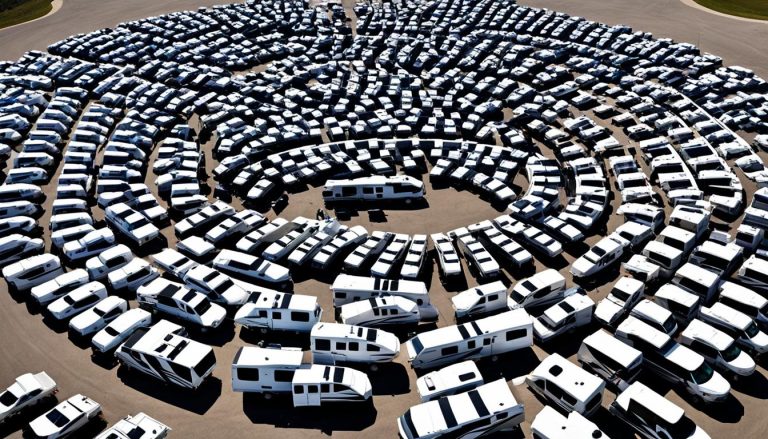Smooth Travels: How to Lubricate RV Slides
gorvlifestyle.com and its partners may earn a commission if you purchase a product through one of our links
RV slide-outs are a common feature in many RVs, allowing for additional living space with the push of a button. However, to ensure smooth operation and prevent costly repairs, regular maintenance and lubrication are essential. By following these tips, you can keep your RV slides gliding smoothly and extend their lifespan.
Key Takeaways:
- Regular lubrication and maintenance are crucial for smooth operation of RV slide-outs.
- Types of RV slide-outs include rack and pinion, hydraulic, cable, and schwintech systems.
- Clean all exposed components before applying lubricant to ensure optimal results.
- Use a high-quality RV slide lubricant and apply a light coating without excess.
- Track your RV maintenance tasks using online tools to stay organized and avoid costly repairs.
Types of RV Slide-Outs
When it comes to RV slide-outs, there are various types commonly found in RVs. Understanding the different types can help you make informed decisions about maintenance and repairs. Below are the main types of RV slide-outs you may encounter:
- Rack and Pinion: Rack and pinion systems are the oldest and most reliable type of RV slide-outs. Known for their durability, they can support large and heavy slides. This type of system uses gears and a pinion to extend and retract the slide-out.
- Hydraulic: Hydraulic systems utilize pressurized lines to operate the slide-outs. Often used for larger slides, these systems provide powerful and smooth operation. Hydraulic slide-outs require regular maintenance to ensure proper functioning.
- Cable: Cable systems are another common type, employing stainless steel cables and pulleys to extend and retract the slide-outs. These systems are known for their simplicity and cost-effectiveness. Regular lubrication and inspection are necessary for optimal performance.
- Schwintech: Schwintech systems are self-adjusting and often found in newer RVs. They offer improved alignment and reliability. This type of slide-out uses a combination of tracks, motors, and gears to operate smoothly.
Each type of RV slide-out has its own unique characteristics and maintenance requirements. By understanding the type of slide-out in your RV, you can ensure proper maintenance and address any issues that may arise.
RV Slide-Out Lubrication
Proper lubrication is crucial for maintaining the smooth operation of your RV slide-outs. Without regular lubrication, the moving components can become stiff, causing friction and potential damage to the system. To ensure your RV slides continue to operate seamlessly, follow these essential lubrication tips:
- Clean Before You Lubricate: Before applying any lubricant, it’s important to clean all exposed components thoroughly. This helps remove any debris or dirt that may have accumulated on the gears, cables, or other moving parts.
- Choose the Best Lubricant: Selecting the right lubricant is crucial for optimal performance. Look for a high-quality RV slide lubricant specifically designed for slide-outs. These lubricants are formulated to withstand the unique demands of the RV environment and provide long-lasting protection.
- Apply Lightly: When applying the lubricant, remember that less is more. Opt for a light coating of lubricant on all the slide-out components. Excess lubricant can attract dirt and grime, creating a messy and potentially damaging buildup.
- Focus on Moving Parts: Pay close attention to the gears, cables, rollers, and any other components that move during the operation of your RV slide-outs. These areas need proper lubrication to ensure smooth and effortless extension and retraction.
Remember, each RV may have specific lubrication requirements outlined in the owner’s manual or recommended by the manufacturer. Following these guidelines will help keep your RV slide-outs in excellent condition, providing you with years of trouble-free operation.
Lubrication Comparison Table
| Lubricant | Key Features | Price | Pros | Cons |
|---|---|---|---|---|
| Brand A RV Slide Lubricant | – Specifically formulated for RV slide-outs – Provides long-lasting lubrication – Resistant to dirt and debris |
$19.99 | – Excellent performance – Easy to apply |
– Slightly pricier than other options |
| Brand B Slide-Out Lubricant | – Suitable for various slide-out mechanisms – Reduces friction and wear – Protects against rust and corrosion |
$14.99 | – Affordable option – Versatile application |
– May require more frequent reapplication |
| Brand C RV Slide Lube | – Long-lasting lubrication – Reduces noise and vibration – Works well in extreme temperatures |
$24.99 | – High-performance formula – Effective in all weather conditions |
– Higher price point |
RV Slide-Out Maintenance
In addition to regular lubrication, properly maintaining your RV slide-outs is essential to ensure their optimal performance and longevity. By implementing a comprehensive maintenance checklist, you can prevent potential issues and costly repairs down the road.
Inspect for Loose Fasteners and Damaged Components
Regularly check all fasteners, such as screws and bolts, that secure your RV slide-outs in place. Tighten any loose fasteners to prevent unnecessary movements that can lead to damage. Inspect the mechanical components, including gears, pulleys, and tracks, for any signs of wear or damage. Replace any worn or damaged parts to maintain smooth operation.
Check for Frayed Cables and Leaking Hydraulic Lines
If you have cable-operated slide-outs, closely examine the cables for any fraying or signs of weakness. Frayed cables should be replaced immediately to avoid potential failures. For hydraulic systems, regularly check for leaks in the hydraulic lines and fittings. Address any leaks promptly to prevent further damage and ensure the hydraulic system operates smoothly.
Inspect Seals for Tears and Weatherproofing
The seals surrounding your RV slide-outs play a crucial role in keeping moisture and debris out. Inspect the seals for any tears or cracks that may compromise their effectiveness. Replace damaged seals to ensure proper weatherproofing, preventing water leaks and potential damage to the interior of your RV.
Check Fluid Level and Test Operation
If you have a hydraulic system, regularly check the fluid level in the reservoir. Follow the manufacturer’s guidelines for proper fluid type and levels. Additionally, test the operation of your RV slide-outs by running them in and out a few times while carefully observing for any unusual noises or grinding. Any abnormal sounds or movements should be investigated and addressed promptly.
By incorporating these maintenance tasks into your routine, you can keep your RV slide-outs in optimal condition, ensuring smooth operation and extending their lifespan.
| Maintenance Task | Frequency | Action |
|---|---|---|
| Inspect fasteners | Monthly | Tighten any loose fasteners |
| Check mechanical components | Bi-annually | Replace worn or damaged parts |
| Examine cables and hydraulic lines | Bi-annually | Replace frayed cables and address leaks |
| Inspect seals | Quarterly | Replace torn or damaged seals |
| Check fluid level | Annually | Top up or replace hydraulic fluid |
| Test slide-out operation | Quarterly | Observe for any unusual noises or movements |
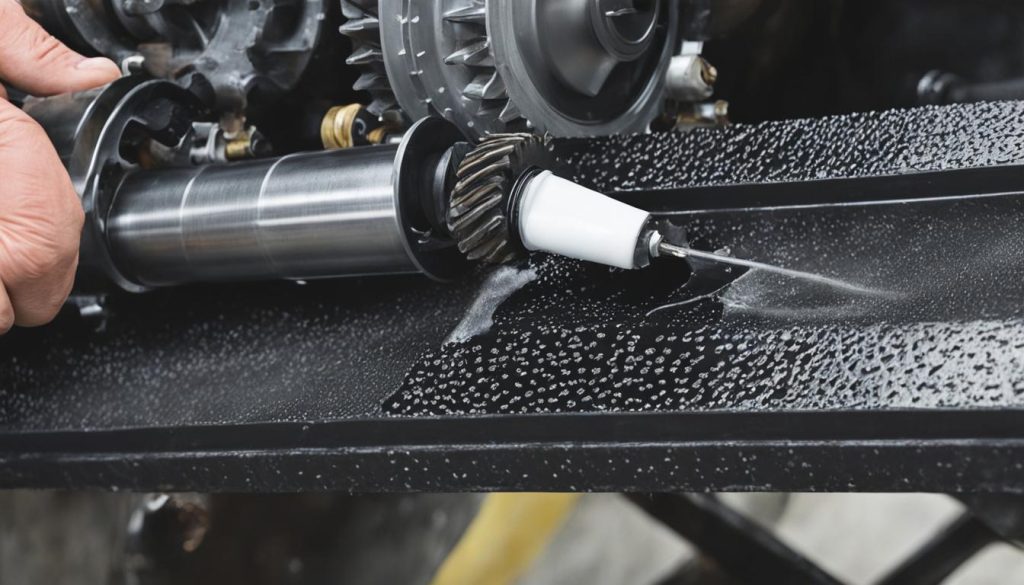
Regular maintenance is key to keeping your RV slide-outs in top shape. By following these tips and adhering to a maintenance schedule, you can enjoy smooth and trouble-free operation of your RV slide-outs for years to come.
Lubrication Tips for RV Slide-Outs
When it comes to maintaining your RV slide-outs, proper lubrication is key to ensure smooth operation and prevent unnecessary wear and tear. Follow these expert tips to keep your RV slides gliding effortlessly and extend their lifespan.
1. Clean Before Lubrication
Before applying any lubricant, it’s important to thoroughly clean all the components of your RV slide-out. Use a gentle cleanser or mild soap to remove dirt, debris, and old lubricant residue. Cleaning the surfaces ensures optimal lubrication and prevents any contaminants from interfering with the moving parts.
2. Choose the Right Lubricant
Using the appropriate lubricant is crucial for effective RV slide-out lubrication. Look for a high-quality, silicone-based lubricant that is specifically formulated for RV slide mechanisms. Avoid using petroleum-based products, as they can attract dust and debris, leading to potential damage. Consult your owner’s manual or contact the manufacturer for any specific lubrication recommendations.
3. Apply Lubricant to Moving Parts
Once you have cleaned the components and chosen the right lubricant, it’s time to apply it to the moving parts. Spray the lubricant onto gears, slides, cables, rollers, and any other areas that experience friction. Be thorough and make sure to cover all the crucial parts of the slide mechanism.
4. Move the Slide In and Out
To reach all areas and ensure even distribution of the lubricant, gently move the slide in and out a couple of times. This will help the lubricant penetrate all the necessary parts and provide smooth operation throughout the entire range of motion. Take your time and observe any areas that may require additional lubrication.
5. Avoid Excess Lubricant
While lubrication is essential, excess lubricant can do more harm than good. Apply a light, even coating of lubricant without overdoing it. Excess lubricant can accumulate debris and create a messy buildup, leading to potential malfunctions. Remember, a little goes a long way.
6. Regular Maintenance and Inspections
Lubricating your RV slide-outs is part of a comprehensive maintenance routine. Regularly inspect all the components for signs of wear, loose fasteners, or any other potential issues. By addressing any problems early on, you can prevent costly repairs and keep your slide-outs functioning optimally.
| Benefits of Proper RV Slide-Out Lubrication | Precautions to Consider |
|---|---|
| 1. Smooth and effortless operation | 1. Avoid using graphite-based lubricants |
| 2. Prevents premature wear and tear | 2. Keep lubricants away from rubber seals |
| 3. Extends the lifespan of your slide-outs | 3. Do not lubricate electrical connections |
| 4. Minimizes the risk of malfunctions | 4. Regularly inspect and replace damaged components |
By following these lubrication tips and incorporating regular maintenance into your RV care routine, you can ensure smooth and trouble-free operation of your RV slide-outs for years to come.
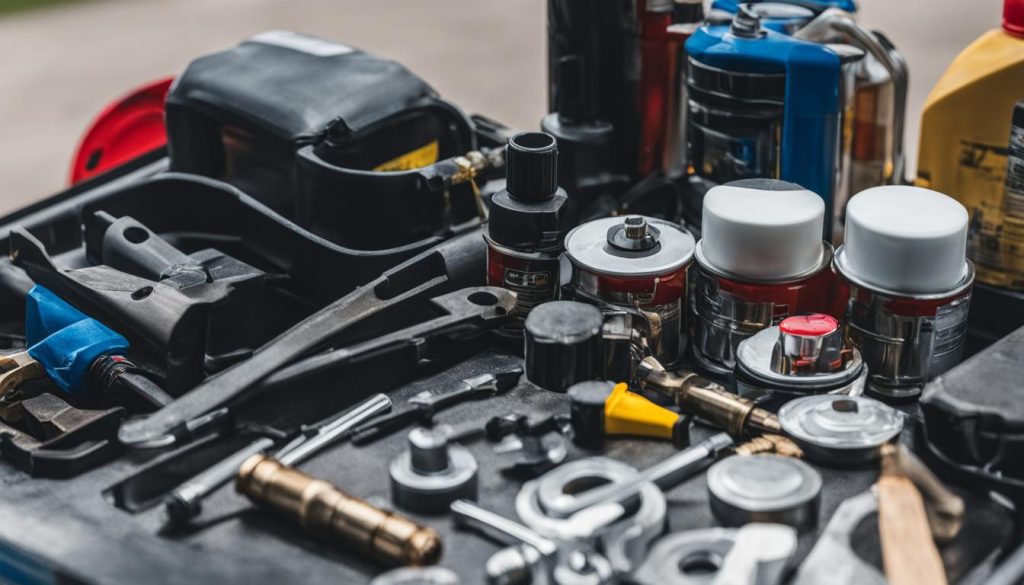
Track Your RV Maintenance
Keeping up with regular maintenance tasks is essential for the smooth operation and longevity of your RV, including properly lubricating your slide-outs. To ensure that you never miss a maintenance task, consider using an online RV maintenance tracking software.
These tools provide a convenient way to stay organized by allowing you to store all your maintenance documents in one place. You can easily access important information, such as lubrication schedules, and set up reminders for when maintenance is due. With timely reminders, you can stay on top of your RV maintenance and prevent costly repairs down the road.
Whether you have a rack and pinion, hydraulic, cable, or schwintech system, an RV maintenance tracking software can help you keep track of all your maintenance tasks, including slide-out lubrication. By following the recommended maintenance schedule and receiving timely reminders, you can ensure that your RV slides continue to operate smoothly and extend their lifespan.
FAQ
How often should I lubricate my RV slides?
It is recommended to lubricate your RV slides at least once a year, or more frequently if you notice any sticking or grinding noises.
What is the best lubricant to use for RV slides?
A high-quality RV slide lubricant is recommended for lubricating gears, cables, and other moving parts. Be sure to use a lubricant specifically designed for RV slide-outs.
How do I clean the components before lubrication?
Use a mild soap and water solution to clean all exposed components. Make sure to remove any debris, dirt, or grease before applying lubricant.
Can I use any lubricant for my RV slides?
It is recommended to use a lubricant specifically designed for RV slide-outs. Other lubricants may attract dirt and debris, causing more harm than good.
Should I lubricate my RV slide-outs when they are extended or retracted?
It is preferable to lubricate your RV slide-outs when they are extended. This allows for better access to all moving parts. However, if necessary, you can lubricate them when retracted as well.
How do I know if my RV slide-outs need maintenance?
Regularly inspect your RV slide-outs for loose fasteners, damaged components, frayed cables, and leaking hydraulic lines. Additionally, listen for any unusual noises or grinding while operating the slides.
Can I use WD-40 for lubricating my RV slides?
While WD-40 is a versatile lubricant, it is not recommended for use on RV slide-outs. Instead, use a lubricant specifically formulated for RV slide mechanisms.
How do I maintain the seals on my RV slide-outs?
Inspect the seals regularly for tears or weathering. If you notice any damage, replace the seals promptly to prevent leaks and water damage.
Can I lubricate my RV slide-outs myself, or should I hire a professional?
With the proper guidance and precautions, you can lubricate your RV slide-outs yourself. However, if you are unsure or uncomfortable performing the maintenance, it is always best to consult a professional.
Should I lubricate the gears and cables of my RV slide-outs?
Yes, it is important to lubricate the gears, cables, and any other moving parts of your RV slide-outs. This helps ensure smooth operation and extends the lifespan of the components.
How can I keep track of my RV maintenance, including lubricating my RV slide-outs?
Utilize RV maintenance tracking software to stay organized with your maintenance tasks. These tools provide reminders, store documents, and help you keep a record of your RV maintenance history.


